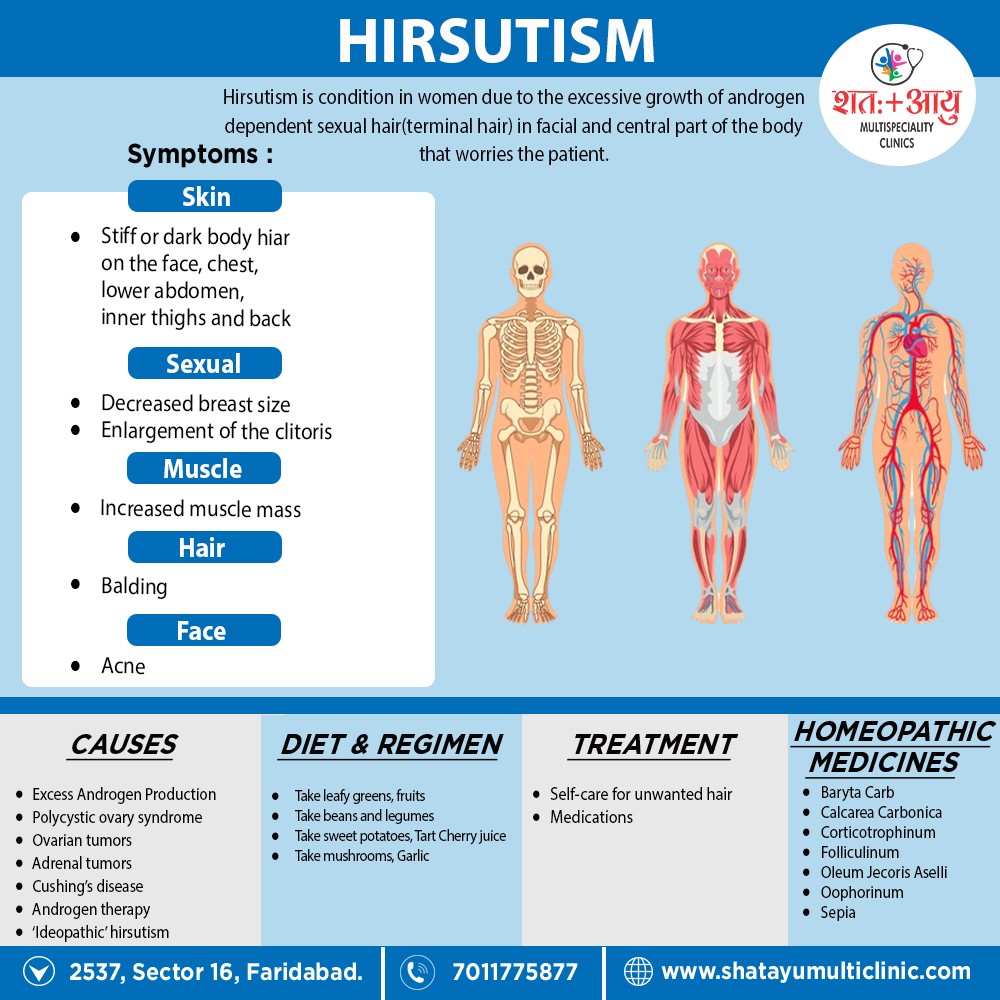Definition of Hirsutism
Hirsutism is the excessive growth of androgen dependent sexual hair (terminal hair) in facial and central part of the body that worries the patient. [1]

Hirsutism is the excessive growth of androgen dependent sexual hair (terminal hair) in facial and central part of the body that worries the patient. [1]
Hypertrichosis: Hypertrichosis connotes excessive growth of non-sexual (fetal lanugo type) hair.
Hyperandrogenism: Hyperandrogenism is a state of increased serum androgen level with or without any biological effect of hyperandrogenemia.
Virilism: Virilism is defined as the presence of any one or more of the following features—deepening of the voice, temporal balding, amenorrhea, enlargement of clitoris (clitoromegaly) and breast atrophy. It is a more severe form of androgen excess. Virilism may be due to adrenal hyperplasia or tumors of adrenal or ovary.
Hirsutism is stiff or dark body hair, appearing on the body where women don’t commonly have hair — primarily the face, chest, lower abdomen, inner thighs and back. People have widely varying opinions on what’s considered excessive.
When high androgen levels cause hirsutism, other signs might develop over time, a process called virilization.
The following guidelines prescribe in an attempt to pinpoint the diagnosis.
During postmenopausal period, there decrease SHBG, more amongst obese patients, resulting in elevate testosterone.
Homeopathy treats the person as a whole. It means that homeopathic treatment focuses on the patient as a person, as well as his pathological condition. The homeopathic medicines selected after a full individualizing examination and case-analysis.
which includes
A miasmatic tendency (predisposition/susceptibility) also often taken into account for the treatment of chronic conditions.
A homeopathy doctor tries to treat more than just the presenting symptoms. The focus is usually on what caused the disease condition? Why ‘this patient’ is sick ‘this way’?.
The disease diagnosis is important but in homeopathy, the cause of disease not just probed to the level of bacteria and viruses. Other factors like mental, emotional and physical stress that could predispose a person to illness also looked for. No a days, even modern medicine also considers a large number of diseases as psychosomatic. The correct homeopathy remedy tries to correct this disease predisposition.
The focus is not on curing the disease but to cure the person who is sick, to restore the health. If a disease pathology not very advanced, homeopathy remedies do give a hope for cure but even in incurable cases, the quality of life can greatly improved with homeopathic medicines.
The homeopathic remedies (medicines) given below indicate the therapeutic affinity but this is not a complete and definite guide to the homeopathy treatment of this condition. The symptoms listed against each homeopathic remedy may not be directly related to this disease because in homeopathy general symptoms and constitutional indications also taken into account for selecting a remedy.
Useful for unwanted facial hair which usually occurs due to a hormonal imbalance.
Useful where PCOS or disturbed menses are the causes for the facial hair to occur.
Usually, the menses are late, scanty with pain in the abdomen.
It also use to treat cases of induration of the ovaries.
Generally, Oophorinum is a medicine prepared from the ovarian extract of a sheep or the cow.
This extract contains oestrogen, progesterone, also follicle stimulating hormone and potentize according to the principles of homeopathy.
In detail, Oophorinum use to treat cases of unwanted facial hair that occur due to ovarian cysts or tumors.
Besides this, It primarily acts upon the female genitalia and the skin.
The patient tends to feel worse during menses, which are too early, profuse, clotted also of brief duration.
Useful for unwanted facial hair that grows on the upper lip. Additionally, Acne on the face may also be present.
Moreover, Menses may be too early, too profuse, and the flow is usually observed at night.
The patient can be thin also anemic, with an excessive dryness of the skin and mouth.
All in all, this medicine is also used to treat female sterility also.
Hirsutism is the excessive growth of androgen dependent sexual hair (terminal hair) in facial and central part of the body that worries the patient.
Stiff or dark body hair, appearing on the body where women don’t commonly have hair — primarily the face, chest, lower abdomen, inner thighs and back.
References